Touring Superleggera at the 2011 Geneva Motor Show - The new Gumpert "Tornante" concept
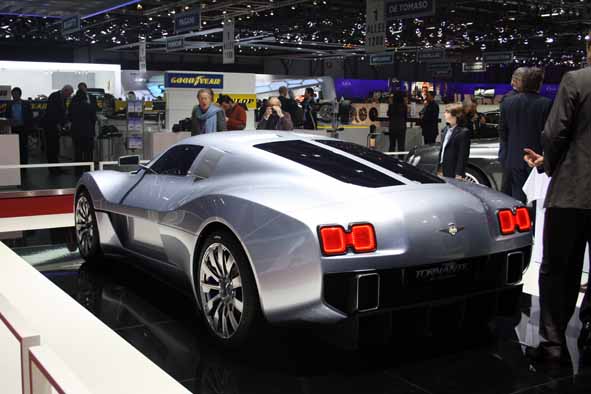
On the 2011 Geneva Motor Show, Touring is celebrating its 85th anniverary showing yet another world première and exploring new grounds for the Milanese coachbuilder.
The 2011 programme of Touring Superleggera is highlighted by collaboration with Gumpert – a sports car manufacturer known for its very demanding engineering and extreme performance – and the Bentley Continental Flying Star, which recently was elected Luxury Car of the Year on the reputed Classic Driver online magazine.
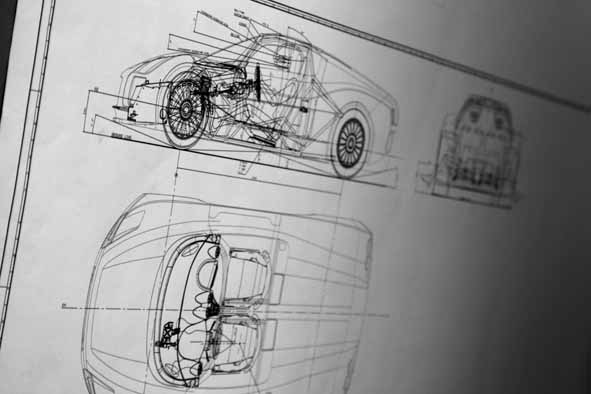
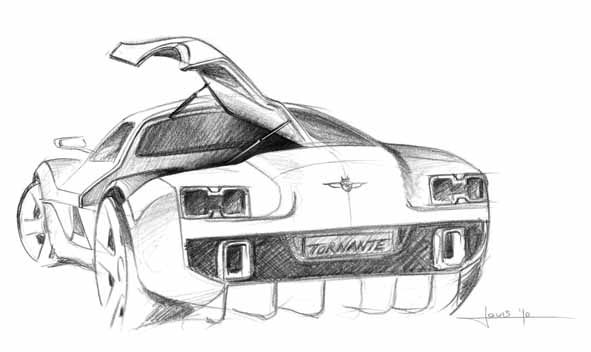
The Gumpert Tornante world premiere, radically different from a noble shooting break, illustrates that Touring’s credo of purity, design integrity, simplicity and balanced proportions can be succesfully applied to a wide variety of automotive concepts.
The Flying Star is getting on stream very well with an increase in production capacity to cope with the growing demand. The Bentley-sanctioned project has definitively positioned Touring on the highest quality levels for custom design and coach building.
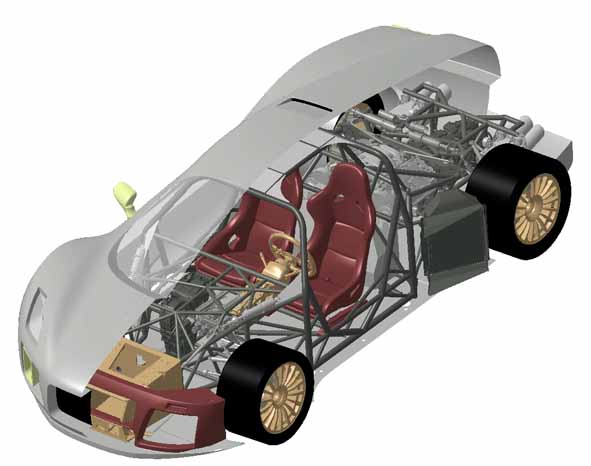
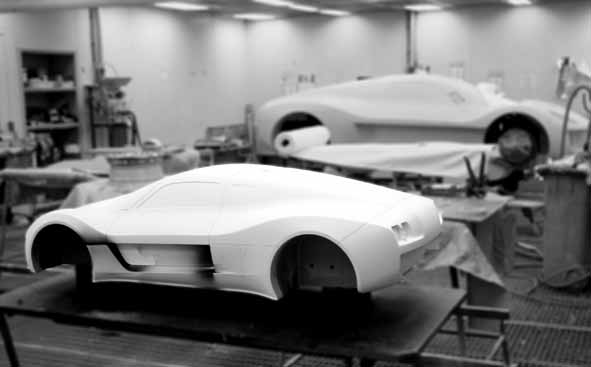
After a successful 2010,Touring is steadlily expanding its portfolio of services as an independent design and service provider for car manufacturers. This encompasses a complete productive cycle from design, renderings, style- and master models, surface development, body engineering to state-of-the-art rolling concepts and low volume coachbuilding. A steady flow of new projects is under development.
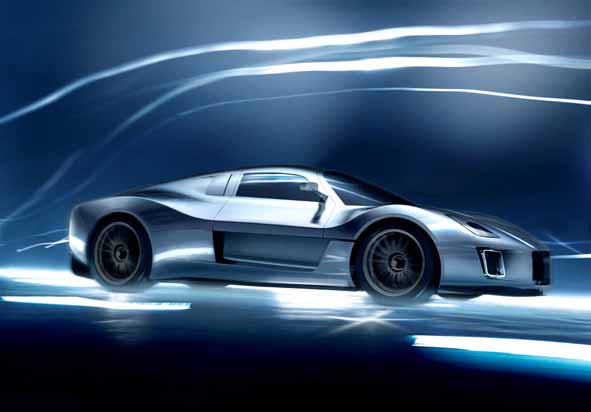
GUMPERT TORNANTE by TOURING
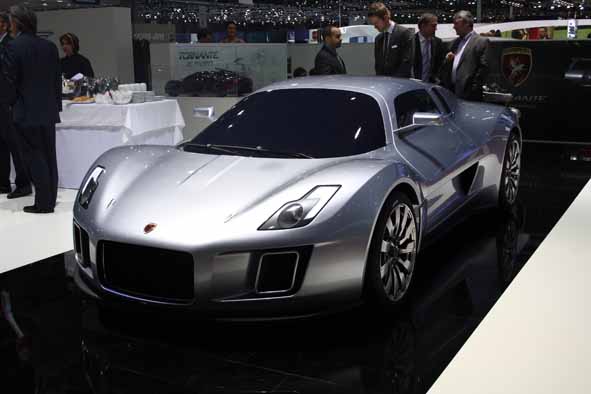
Touring Superleggera and Gumpert have chosen the 2011 Geneva Motor Show stage for the world premiere of the Tornante.
Touring Superleggera provided the design and body engineering while Gumpert will take care of manufacturing and sales of the next model, complementing the Gumpert range as of 2012.
The Tornante is showcased at the stage of 1:1 static style model in the best Italian tradition.
Fast tourer
Gumpert have gained a reputation for their impressive street legal racing cars. They addressed Touring Superleggera with a call for elegance, more passengers and luggage space, improved comfort, access and ventilation, and noise reduction. However, the fundamentals of performance and dynamic properties had to be respected without compromise.
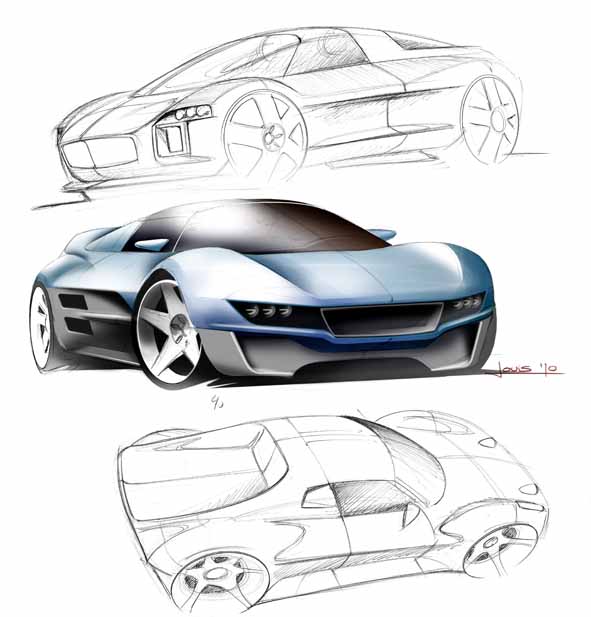
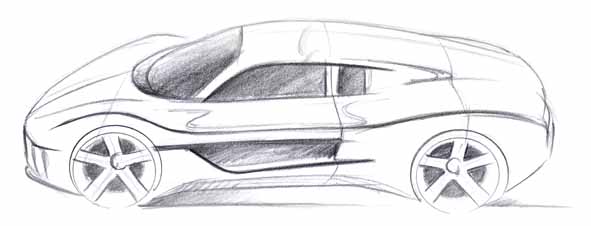
At Touring, designers and body engineers started then a process of creative elimination to define the true essentials of all the parameters involved, limiting unnecessary weight and volume.
The result is still a thoroughbred, just a few grades more civilized, with some extra skills for an enjoyable voyage. It is called a fast tourer. However, let there be no misunderstanding about its intentions.
Project development
When selecting the partner for the new model's body design, Gumpert recognised that elegance is part of the genetic code of Touring Superleggera's creations. Even more remarkably, the paradigm of elegance was applied by Touring to the race cars too.
This distinctive approach was at the basis of many masterpieces, like the 1940 Mille Miglia winner BMW 328 Berlinetta, the Ferrari 166 and 340 and the inspiring Alfa Romeo 8C2900. They all were redoubtable race machines with singular grace.
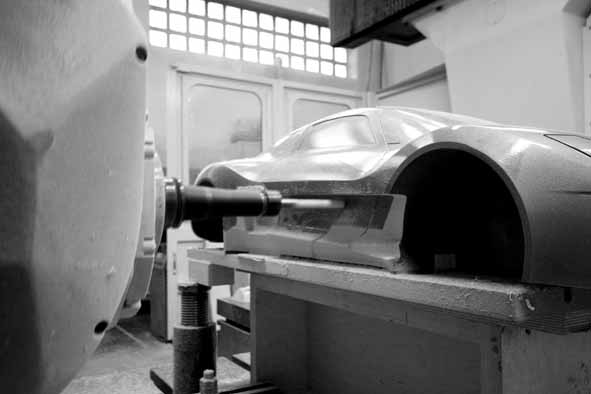
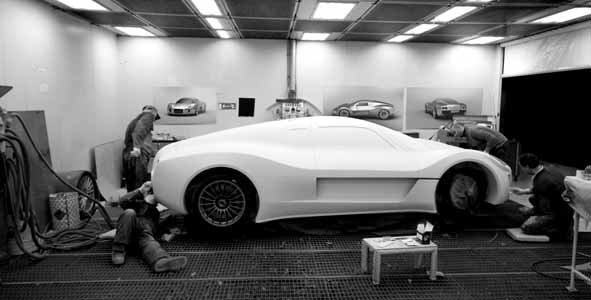
In turn, Touring was intrigued by the challenge from the young, vital and ambitious sports car manufacturer, known for uncompromised orientation to efficiency, high quality engineering and the constant quest for better performance.
In the development work, the teams from the two companies discovered soon that they share the same respect for efficiency and essentiality. This facilitated the subsequent stages of engineering and feasibility study, and the merger of body and chassis required only minor adjustments from both sides.
Architecture
The space frame chassis is a derivative of the apollo and features the same central engine layout.
However, the requirements of accessibility and inner space have dictated a number of important changes to the rolling chassis:
- the lateral member of the chassis is lowered by 80mm in the door area
- the A pillar and the windshield are rotated vertically by 2.5°
- the B pillar is moved backwards with 100 mm allowing for 1120cm wide gullwing doors
- the H point is displaced by 210mm in height and 46mm in length
- the overall height is now 1215 mm
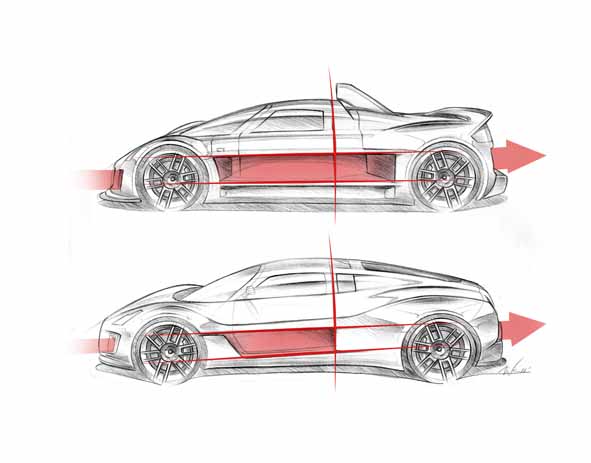
Thanks to the thorough frame engineering, the outstanding combination of lightness and torsional stiffness of the original chassis is preserved. The engineers target 100kg and slightly lower than 40.000Nm/degree, but the passenger compartment volume is now increased by 25% and the luggage compartment capacity is brought to 200l.
Other modifications aim at enhanced ride comfort and driveability:
- the floor height is increased by 20mm
- the shell seats are fully adjustable, heated, with 4-point belts
- the paddle shifters are standard feature
- sound and heat insulation material is fitted on the floor and between the cabin and the engine compartment
- glasses are double layer for better heat and noise insulation
- the ventilation system capacity is improved
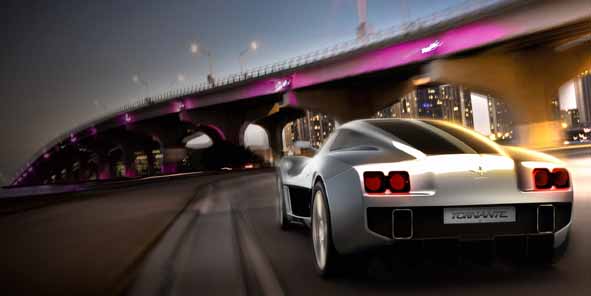
A crash box in the front section, adapted from Formula-1 technology, absorbs the impact energy in case of a crash, improving the passive safety.
Featuring composite body panels over the light chrome-molybdenum steel space frame with carbon fibre monocoque, the construction principle mirrors the original method patented by Touring in 1936, and authorizes the symmetrical Superleggera badges on the bonnet.
Design
Unlike other Touring creations, the Tornante is not rooted into a specific model of the Italian designer's heritage. Aesthetically, the project started from a white sheet of paper, allowing the designer’s full and free focus on the challenging package of the rolling chassis and its hard points. The new model should not only offer ample performance and superb dynamic properties and aerodynamics, but also adequate levels of comfort, interior space and ergonomics.
The spirit of a true dream car, but with sufficient practical features to become a safe and useable sports car in today's' traffic.
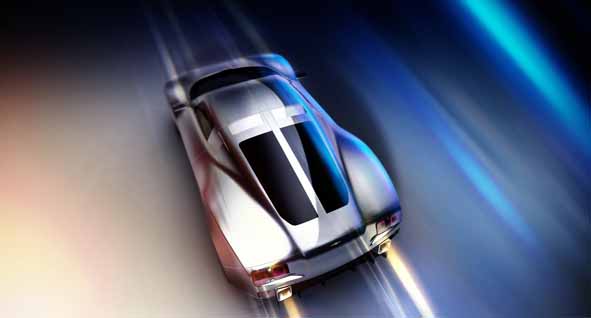
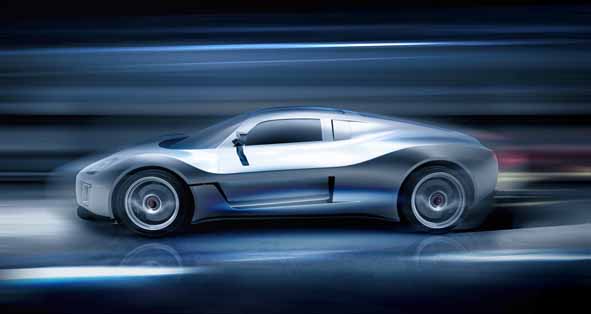
The Touring accent of the Tornante originates from specific proportions and the balance of muscular elegance and introvert power, rather than formal language. The bodywork preserves its movement even when the car stands still, and when on the move, it expresses unique, elegant fluidness.
The prominent grille within the balanced front wings characterizes the Tornante’s front area. The air intakes are pronounced, reflecting the care given to the air intake surface and the overall airflow.
The well-defined waistline reflects the functional separation between the greenhouse and the lower body. The top is a light area offering extended space for driver and passenger, overall visibility and sportive but comfortable ‘life on board’. The muscular, though elegant shoulders announce the stunning performance of the power unit.
Both the Tornante’s doors and the boot lid open with gullwing movement, providing easy access to the interior, the mechanics and the luggage compartment.
From the rear, the low quarter panels outline the powerful curve of the roof. Below the waistline, the very visible air diffuser evokes the research of the maximal downforce.
The overall design breaths superior potential and performance in an elegant and slightly understated way, faithful to the Touring tradition.
Power Unit
The Tornante has the genes of the Gumpert apollo and inherits its impressive V8 Biturbo engine. Weighing only 196kg, the engine plays a major role in ensuring the ideal weight and the fascinating driving dynamics of the Tornante. An angle of 90° between the two cylinder banks is a sign of a classic 8-cylinder engine.
Starting from the pure block from Audi, the engine is a complete in-house development. Thus, the manufacturing process contains among others all the moving parts, air and fuel management, turbo chargers, charge air-duct and dry sump lubrication. In the basic version this engine delivers 700HP. In comparison to the apollo, the configuration will be optimized for the fast touring mission. This means more comfort and more suitability for daily use.
Alongside the V8 power unit, an alternative powered Tornante is also planned for 2012.
Driveline
The fully synchronised, automatic six-speed transmission guarantees efficient utilization of the remarkable energy at the back wheels. The arrangement of the gears in a longitudinal direction in the path of travel ensures a very low centre of gravity and optimum weight distribution.
Extremely short gearshifts up to 40 milliseconds (torque-to-torque) are provided by the precise TT40e transmission of the apollo, where "e" stands for electronic gear system. Gear changes are faster thanks to rocker switches on the steering wheel.
The Formula 1-type technology promises the ultimate in comfort along with best driving performance.
Suspension
The apollo derived built-in suspension ideally complements the body‘s sophisticated aerodynamics. The Tornante owes the finely tuned sensitivity of the suspension system and the optimised exertion of power to its double transverse control arm pushrod configuration at front and rear.
The double wishbones ensure that the tires maintain optimum contact to the road surface, independently of the bound rate of suspension system. As the suspension elements are linked to the main frame, the system ensures a responsive reaction and precise handling.
Chassis
Made of top-quality and highly stable chrome-molybdenum-steel with an integrated safety cell, the round tube frame is the base and symbolic backbone of the Tornante. Providing additional space and comfort for its passengers compared to the apollo, the Tornante will be as safe as its racetrack-dedicated brother is.
The Tornante succeeds in combining low weight and rigidity with finest driving dynamics and comfortable fast touring.
TECHNICAL DATA
2-seater sports car with a mid-engine arrangement, chrome-molybdenum steel chassis with an integrated safety cell, doors and the boot lid open with gullwings, carbon body, 100 l stainless steel tank behind the passenger cell with integrated catch tank, long and pushrod-operated double transverse control arm suspension with fully adjustable dampers front and rear and anti roll bar in front, ground clearance adjustable between 60 and 140 mm, two circuit ABS brake system with six piston callipers, inside ventilated discs (378 x 32 mm) at front and rear.
Dimensions
Length mm 4,475
Width mm 1,971
Height mm 1,215
Wheel base mm 2,700
Track front / back mm 1,648 / 1,600
Boot volume l ca. 200
Weight
Kerb weight (depending on equipment components) kg 1,300 – 1,400
Engine
V8-cylinder-Biturboengine with 90° cylinder angle, Closed-Deck light metal crankcase, light metal cylinder heads with five valves per cylinder, four overhead camshafts, variable time of ignition (Vario Cam direct) on the intake, hydraulic valve clearance compensation, dry sump lubrication, double-flow exhaust system with 3-way catalytic converter, four Lambda probes for gas mixture and diagnostics, On-board diagnostic system, 2 Intercoolers, electronic ignition with a rested ignition distribution (eight ignition coils), sequential multipoint fuel injection, electronic accelerator system (drive-by-wire)
Cylinder / type / valves per cylinder 8 / 90°-V/5
Cubic capacity cm³ 4,163
Stroke - Bore mm 93 / 84,5
Nominal output kW / HP at rev / min 515/700 at 6,500
Max. torque Nm / lb ft at rev / min 900/663.7 at 4,000
Maximum rev rev / min 7,400
Litre performance kW/I / HP/I 123.7 / 156.1
Compression / recommended fuel type 9.3 / 98 ROZ / 88 MOZ
Emission standard Euro 5
Gearbox
Automatic six-speed gear box TT40e with synchronization and oil cooling, operated with paddle shift controls, twin plate clutch configuration (diameter 240 mm), Torsen differential lock
Wheels
Tires Michelin Pilot Super Sport front 265/35 ZR19, back 345/30 ZR20
Wheel dimension front 10 J, back 13 J
Wheel rim type Aluminum cast or forged wheels with centre lock
PERFORMANCE FIGURES
Top speed (est.) km/h above 300
All information is dated February 2011 and could be changed until production start.
Touring Superleggera increases the production capacity
of the Bentley Continental Flying Star
The manufacturing of the third Bentley Continental Flying Star is almost completed in the Milano atelier.
To cope with the requests, Touring has invested in tooling, technology and additional workforce to reach a production capacity of 5 units in parallel, and keep the 6-months delivery term.
The total series is foreseen in a maximum of 19 cars, all manufactured on order to personal specifications. The mechanical base is the Continental GTC, with power outputs ranging from 560 to 630 PS.
The ingredients of the car’s success are multiple. "Before all, the strong and unmistakable design was much appreciated – notes Piero Mancardi, CEO of Touring -. It combines elegance and sportiveness. It is timeless, and perfectly in line with the Touring heritage. Moreover, the very limited production is a parameter for collectability and a driver of the car’s future value, though the Flying Star is very practical and fit for everyday use. In fact, the compliance with Bentley Motors' quality and engineering standard allows for warranty and service through the regular Bentley dealer network.
Commissioners also appreciate the value of the 4000 hours of handwork by a team of extraordinary craftsmanship, inheriting 85 years of experience and tradition."
The concept of shooting brake combines a two-door, high performance sports car with a wide and accessible luggage compartment, which is fit for the longest of travels. These features inspired the owner of the Flying Star nr. 2 showcased in Geneva. The commissioner expressed his desire for a true grand tourer, for trips with family and dog, to be paired with his current Continental GT in the same colour combination. The car thus was finished in Cypress Green, with an interior in Nautic Blue and Hotspur Red. To allow maximum space for the dog, the luggage compartment was lowered by an extra six centimetres. Unsurprisingly, a water bowl for the dog in coordinated leather trim is on the specifications list.
The Flying Star nr. 3 is ordered in Crystal Blue with a tan interior. Like nr. 2, it features a number of aesthetical and technical improvements made possible by the mix of advanced technologies and craftsmanship typical of the Touring Superleggera process. The boot lid now opens faster and wider, using directly driven gears. The rear compartment gets new luggage retention anchorages. For further weight reduction, Touring is currently studying the use of carbon fibre for the rear boot lid, the rear wings and the complete roof section.
Carrozzeria Touring Superleggera
Founded by Felice Bianchi Anderloni and Gaetano Ponzoni in 1926, the company started to produce custom built automotive bodywork with two distinctive features from the very beginning: sporting elegance and lightness.
Early customers were reputed car makers as Isotta Fraschini and Alfa Romeo. It would mark the start of a flamboyant period, also culminating in the ‘Flying Star’ period with several spectacular spider coachworks.
Touring Superleggera also gradually researched the streamlining process. The marriage between this, and their Superleggera construction system using aluminium body panels over a light but rigid tubular steel frame, resulted in some extremely elegant masterpieces such as the 1938 Alfa Romeo 8C2900 Touring spider, which today have become icons of automotive design and body construction.
In 1945, the excellent Carlo Felice Bianchi Anderloni joined his father at the company, which soon started to receive its first orders from a motivated Modenese entrepreneur called Enzo Ferrari. The Tipo 166 Touring ‘Barchetta’ of 1950 formed a new milestone for light, elegant and effective design on a competition chassis.
Under Carlo Felice, Touring saw its industrial customer basis grow in the mainstream of the expanding automotive industry in Italy and Europe. A number of niche models were designed and built on Alfa Romeo 1900, Lancia Flaminia and Maserati 3500. Another new inspired car manufacturer from the Bologna area relied on Touring’s skills: Lamborghini. At the same time, Aston Martin produced their DB4, 5 and 6 models with a license for the Superleggera system.
The energy crises of the early seventies, and the increasing mass production methods in the car industry would regretfully force many specialist companies to close their doors. The last production car left Carrozzeria Touring in 1966, but the true Touring spirit was firmly consolidated in the company’s products, that found their ways to an international community of motoring enthusiasts and car collectors.
In 2006, the year of its 80th anniversary, Carrozzeria Touring Superleggera of Milan restarted its activities, now part of Zeta Europe BV, a private company specializing in automotive high-end products and brands.
















 History of "Menu dei Motori"
History of "Menu dei Motori"

 DESIGN PROJECT
DESIGN PROJECT UNIVERSITA' DI MODENA
UNIVERSITA' DI MODENA








Comments
Nessun commento presente
Add Comment